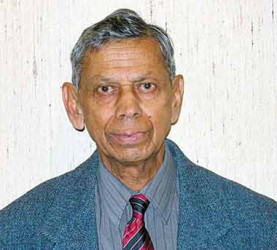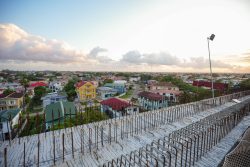[Frank Birbalsingh, Guyana: History and Litera-ture, United Kingdom: Hansib, 2016. 324p. L11.99.]
Guyanese author, academic, editor, anthologist and literary critic Frank Birbalsingh begins the Preface to his account of Guyana: History and Literature (UK: Hansib, 2016) with a brief summary of the geographic location, history, geopolitics, demography and the resulting attitudes of Guyana’s people. He identifies its uniqueness as the only English speaking nation in South America, and continues thus:
 “As a former British colony it might be compared with Belize (formerly British Honduras) the only English speaking nation in Central America, except that Belize has strong and historic relations with Spanish speaking neighbours. Guyana, meanwhile, has one foot – its North-Eastern Atlantic coast – that dips in the Caribbean Sea, and the other buried deep into the Amazon forest, which seals the territory off from neighbours such as Venezuela in the West, Brazil in the South and Suriname in the East. There is no doubt of Guyana’s strong, creole, cultural links to English speaking Caribbean islands like Jamaica and Barbados, with similar populations mainly of African descent; but its South American location, between a huge forest and a wide sea, also suggests a continental component within its national profile.”
“As a former British colony it might be compared with Belize (formerly British Honduras) the only English speaking nation in Central America, except that Belize has strong and historic relations with Spanish speaking neighbours. Guyana, meanwhile, has one foot – its North-Eastern Atlantic coast – that dips in the Caribbean Sea, and the other buried deep into the Amazon forest, which seals the territory off from neighbours such as Venezuela in the West, Brazil in the South and Suriname in the East. There is no doubt of Guyana’s strong, creole, cultural links to English speaking Caribbean islands like Jamaica and Barbados, with similar populations mainly of African descent; but its South American location, between a huge forest and a wide sea, also suggests a continental component within its national profile.”
Birbalsingh follows that with a synopsis of the history which shaped Guyana’s demographics, politics and quirks of nationhood. We spend time on this introduction to the book because at the same time it sets the tone of the contents of the volume while doing no justice to the document itself.

The comparison with Belize is inspired because it is surprisingly relevant and new – no one remembers that Belize is the only English-speaking nation in Central America, an interesting and significant fact in the context of Guyana, but thereafter, Birbalsingh’s contrasts go awry. Belize has a territorial quarrel with neighbouring Guatemala which has made claims to its space, not unlike Guyana’s Venezuela problem. Birbalsingh strikes an accurate note about ties since Belize’s Spanish-speaking population probably outnumbers its English speakers, while its deeply cultural Amerindian communities are more integrated into the rest of the country than Guyana’s.
But Birbalsingh goes astray because Guyana’s Amazon forest does not “seal the territory off from neighbours.” As far as the Amerindians living in the forest extremes are concerned the neighbouring countries are almost borderless, sometimes this is assisted by the forests. Because of forests, Guyana’s interior borders are porous – in some ways, dangerously so, while there is busy normal traffic and interaction between Guyana and all three neighbours – Brazil, Surinam and Venezuela.
The comparison of Guyana’s population with Jamaica and Barbados goes askew – the population in those two islands being “mainly of African descent,” is quite unlike Guyana and Trinidad where there are East Indians in greater numbers. Some of these discrepancies matter, because Professor Birbalsingh wants to give international readers a good idea of the nation he is writing about. They also matter since the main strength of the book Guyana: History and Literature is in the way it relates the several publications – the various works of fiction, non-fiction and history to these very cultural dynamics of the nation of Guyana. These include the racial make-up of the population and the historical conflicts that have plagued it, as well as several social, political, geographical and racial issues that always reveal themselves in the many works that Birbalsingh reviews.
Also, by design of the author and the publishers, this is a volume strategically released to commemorate Guyana’s Golden Jubilee, its 50th anniversary as an independent nation. The audience, therefore gets a broad, impactful survey of a wide range of Guyanese literature. It also provides an insight into political writings about the country, some of which is partisan, but many of which touch on important issues that either damn or celebrate the country. The collection of reviews certainly confronts issues, especially the racial ones, in addition to the presentation of a picture of a multi-cultural community of both neighbours and combatants. It elucidates a society coloured by religion, race and politics, deep-rooted economic angst and attempts at nation building. The collection also reviews historical texts that try to define the nation based on its colonial past and many of the major players in the twentieth century.
If one does not see Birbalsingh’s book in this way, it might be relegated to a motley collection of disparate comments by the author on various Guyanese publications. Some are brilliantly reviewed, while others are described with minimal critical input and Guyanese “history and literature” becomes a broad generalised collection of any works written by Guyanese or about Guyana. However, another strength of the book is that the pieces are quite brief, sometimes too brief for their own sense of depth, but very readable; sometimes readable because of that brevity and succinctness. They bring together all in one volume, attention to several important publications of the nation’s history and literature – so wide that one would have to wander around libraries and the world wide web to put a finger on them. To Birbalsingh’s credit he has brought together a considerable volume of reading.
This range of reading dates back to the early twentieth century and sweeps right up to the present time, including attention to many new and recent texts. Sometimes the windows opened by Birbalsingh to the texts are through secondary sources and he reviews the coverage of the texts while allowing an appreciation of the British Guianese society of the time. For example, the collection manages to cover the world depicted by ARF Webber through the work of Selwyn Cudjoe, while also taking his audience back to the works of Norman E Cameron. While Webber’s Those That Be In Bondage: A Tale of Indian Indentures and Sunlit Western Waters (1917) presents a picture of the hardships of East Indian sugar estate workers, Cameron had a concern for the image of black people in British Guiana. It is the same concern for a constituent ethnic group that drove the work of Joseph Ruhomon and others that led to the rise of Indian social and cultural clubs and of equivalent black leagues and societies in the 1930s.
Clem Seecharran who wrote about this rise in ethnic consciousness in the early twentieth century, is reviewed by Birbalsingh, particularly his more recent work Sweetening Bitter Sugar: Jock Campbell, the Booker Reformer in British Guiana (2005) that reveals much about both sugar and government in the colony. The comparisons allowed by this coverage move in two directions. They take us back to Webber, sugar and the estates at the time of indentureship on the one hand, and on the other, a view into the same period as Campbell. This second is afforded by the review of Yesu Persaud’s autobiography Reaching for the Stars (2014) with its inside stories of the boardrooms crossing over from colony to independence. At the same time Persaud tells of life in the logies on the estates of the 1940s.
That is some of what happens with the non-fiction and historical texts. But other kinds of comparisons are possible because Birbalsingh touches on Edgar Mittelholzer, referring to his Corentyne Thunder, which in 1941 established true realism in Guyanese fiction with his own dramatisation of life among East Indian peasants and estate workers in the 1930s. This attention to Mittelholzer testifies to the way Guyana: History and Literature covers the literature from early to contemporary and from major to a number of minor writers. The collection seems to have gone into every corner of Guyanese literature to recognise a few of the unrecognised, introducing readers to less established novelists.
Birbalsingh, who once chaired the Jury for the Guyana Prize for Literature, is able to review some works and authors who either won the Guyana Prize or who were shortlisted. He is able to unearth the unestablished such as Clive Sankardayal, whose Brown Curtains is startlingly revealing in its treatment of migration to St Lucia, flight from the PNC government of the 1980s and racial prejudice. He also brings to the surface Moses Nagamootoo whose Hendree’s Cure similarly highlights race relations, but also delves into local village life and traditions.
Like Sankardayal, Sasenarine Persaud has dealt with migration and the reign of the PNC regime. Birbalsingh is able to identify the wave of writings about that political regime that began to emerge among Guyanese writers in exile in the 1990s. Sasenarine Persaud is among those who created such writings and he is one of the many established Guyanese authors reviewed by Birbalsingh.
This collection treats the work, therefore of the country’s leading writers. There are notices of Pauline Melville, Mark McWatt, Wilson Harris, Fred D’Aguiar, Roy Heath, Ian McDonald, Michael Gilkes, Mahadai Das, Oonya Kempadoo and Jan Lowe Shinebourne. Then as one reads through the multitudes of short reviews one encounters others such as Cyril Dabydeen, Ryhaan Shah, Janet Naidoo, ND Williams, Chaitram Singh, Ruel Johnson and Rooplall Monar.
There are many historical works that get attention, such as those of Dale Bisnauth, Basdeo Mangroo, Jaduman Seecoomar, Shridath Sonny Ramphal, Jai Narine Singh, Gaiutra Bahadur and James Rodway. These include historians, researchers, political commentators and writers of creative non-fiction.
Frank Birbalsingh is a professor of English with vast experience who has worked at the University of York. He has been prolific with many works on Guyanese literature, oral history, and anthologies. Guyana: History and Literature is not a strong focus on any theme or any genre, but it can serve as a useful document of Guyanese writing, particularly when published in a year that highlights the country’s major achievement of nationhood. It is 50 years of independence not only of the country, but of its literature.




